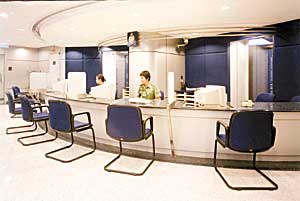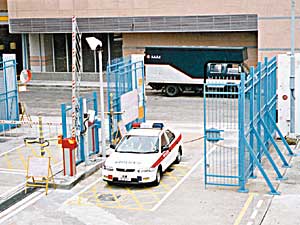Approval for station revamps
Station improvement funds approved!
The Legislative Council approved almost $650 million on July 9 for the upgrading of 59 police stations and operational facilities across Hong Kong.
Deputy Commissioner of Police (Management) Tsang Yam-pui hailed the decision as an important milestone in the implementation of the Customer Service Improvement Project to improve service quality, which will make the Force a world leader.
The Legislative Council Finance Committee approved $649 million on July 9 to improve 59 police stations and operational facilities.
 A taste of the station improvements to come |
Commenting on the standard of work already achieved at the three pilot stations North Point, Sha Tin and Sau Mau Ping, Mr Tsang said he believed with the completion of the project over the next three years, the Force would become a "world leader" in the standard of services and facilities provided to the public.
He said the works would also provide a better environment and working conditions for staff which was essential to Police efforts to bring about a new culture of service and a Force better trained to serve the public.
"I believe the standard of designs adopted in the report rooms and areas where the public have access reflects the unique role of the Force, places emphasis on user friendliness and projects a sense of professionalism and service to the community," Mr Tsang said.
Planning and Development Branch Chief Superintendent David Thomas said for he and his team, the successful funding of the project culminated some 18 months in planning work. Mr Thomas said the new report rooms were of an intelligent design and would allow the integration of 21st Century technology, as conduiting had already been provided. An example was the provision of touch-screen computers for the public to obtain quick and easy access to information.
"The new materials will also be long-lasting and require less maintenance than more conventional finishes which have hitherto been used," Mr Thomas said. While the successful funding was a substantial turning point, Mr Thomas added that much of the challenging work now laid ahead, and the success of implementing the project would rely largely on sound co-ordination and close teamwork.
Director of Finance, Administration and Planning Keith Kwok Ka-keung stressed the importance of good co-ordination, communication and keeping procedures as simple as possible. He said the Station Improvement Project Works Steering Committee had already been formed under the chairmanship of Mr Thomas with a broad representation including the valuable input of Service Quality Wing.
Project manager, P & D Branch Superintendent Graham Lander, said the works comprised: the upgrading of report rooms and public areas; the provision of air-conditioning; improved ablutions and custom-built kit lockers for all officers; the creation of resource centres with computer facilities including Internet access; newly created interview rooms and redesigned duty offices with workstations; facilities for the disabled; and the installation of an Automated Station Security Scheme.
 Spot check: A patrol car is allowed to enter a police station through the new electronic security system, part of the improvement project |
Works are scheduled to start in October and will continue for three years.
The tentative starting dates for each station are: October-December 1999 - Western, Mong Kok, Tuen Mun, Kwai Tsing, Yau Ma Tei, Wong Tai Sin, Sham Shui Po, Sheung Shui and Cheung Chau.
January to June, 2000 - Central, Ho Man Tin, Sai Kung, Tin Sum, Wan Chai, Kwun Tong, Pat Heung, Ma On Shan, Marine West, Chai Wan, Tsim Sha Tsui, Ngau Tau Kok and Tai Po. Sau Mau Ping and North Point will have automatic security system works only.
July to December, 2000 - Waterfront, Cheung Sha Wan, Border, Tsuen Wan, Siu Lek Yuen, Yuen Long, Marine South, Launtau North, Tseung Kwan O, Kowloon City, Tai Hing and Marine North.
January to June, 2001 - Aberdeen, Shek Kip Mei, Tsing Yi, Lok Ma Chau, Shau Kei Wan, Lantau South, Marine East, Happy Valley, Tsz Wan Shan, Lei Muk Shue, Tin Shui Wai and Sha Tau Kok.
July to December, 2001 - Hung Hom, Castle Peak, Stanley, Lo Wu, Lamma Island, Man Kam To, Marine Harbour, Ta Kwu Ling and Lok Ma Chau Border Crossing Point. Airport station will have automated security system works only .
Information bulletins will be published regularly by P & D Branch to update staff on the project.
<< Back to Index >>